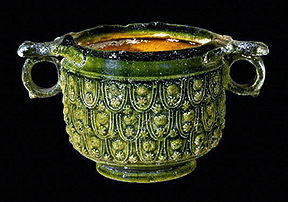
Roman, about 50 BCE - 50 CE
From Tarsus, south-eastern Turkey
Pottery with lead-based glaze
Height: 7 cm
Acquisition number: #GR 1931.5-14.1
Image courtesy of the British Museum (copyright reserved)
The use of lead-based glaze appears to have been invented in the Mediterranean sometime prior to the second century BCE. Lead-glaze wares were exported to the Middle East and Western Asia in the second century BCE, and soon after potters in Western and Central Asia were creating their own lead glazes. The technology eventually made it as far as Han China, where it was used to imitate the look of bronze vessels. Though the Chinese eventually lost interest in the technique, lead-glaze wares continued to be made in Roman territories for both domestic consumption and for export both to Asia and to the European kingdoms to the north of the Mediterranean.
This drinking cup, created in a popular two-handled shape is called a skyphos. It is believed that the grayish-green hues common to lead glazes were originally intended to imitate metal tableware, just as they were used in China to imitate bronze. Eventually the glaze came to be produced using different colors, such as the rich greens and yellow-browns we see here, and was appreciated for its own sake.
(1) See the British Museum web page dedicated to this object.